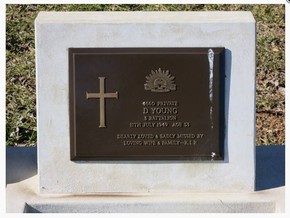YOUNG, Douglas
| Service Number: | 4660 |
|---|---|
| Enlisted: | 8 August 1915 |
| Last Rank: | Private |
| Last Unit: | 3rd Infantry Battalion |
| Born: | Coonamble, New South Wales, Australia, 1895 |
| Home Town: | Mudgee, Mid-Western Regional, New South Wales |
| Schooling: | Not yet discovered |
| Occupation: | Letter carrier |
| Died: | Sydney, New South Wales, Australia, 11 July 1949, cause of death not yet discovered |
| Cemetery: |
Rookwood Cemeteries & Crematorium, New South Wales RC; M2 14, 958 |
| Memorials: |
World War 1 Service
| 8 Aug 1915: | Enlisted AIF WW1, Private, 4660, 3rd Infantry Battalion | |
|---|---|---|
| 15 Jan 1916: | Involvement Private, 4660, 3rd Infantry Battalion, --- :embarkation_roll: roll_number: '7' embarkation_place: Sydney embarkation_ship: RMS Osterley embarkation_ship_number: '' public_note: '' | |
| 15 Jan 1916: | Embarked Private, 4660, 3rd Infantry Battalion, RMS Osterley, Sydney | |
| 17 Aug 1916: | Wounded AIF WW1, Private, 4660, 3rd Infantry Battalion, Gun shot wound to neck (dangerously ill) | |
| 17 Mar 1917: | Embarked AIF WW1, Private, 4660, 3rd Infantry Battalion, Returned to Australia per HMAT Beltana | |
| 16 Jun 1917: | Discharged AIF WW1, Private, 4660, 3rd Infantry Battalion |
Help us honour Douglas Young's service by contributing information, stories, and images so that they can be preserved for future generations.
Add my storyBiography contributed by Stephen Brooks
Douglas Young was one of 5 brothers who served in the AIF during WW1. He was wounded in action 17 August 1916, a severe gun shot wound to the neck and paralysis to the left side of the body. He was evacuated to England and returned to Australia 17 March 1917. It is not known he fared after the war.
Two of his brothers lost their lives, and also two uncles, brothers of his father, William Ralph Young.
His dad wrote a letter to the AIF dated 25th September 1916, which is in his service file,
“Could you oblige me with answers to the enclosed list of questions?
I saw in one of our Sydney papers that while the Gallipoli campaign was in progress there was a staff of 300(underlined) in England, when the Australian Army was sent to England a staff (300) also went with it. Now 600 is a very fair staff (non combatant) so I think in all fairness I am to be excused in expecting some information. Yours W.R. Young
P.S. I hope you will not deem my comments impertinent. I sent 4 sons to the front, one dead, one dangerously wounded, one invalided home and the other to all intents and purposes lost.
One brother killed in action.
7 nephews--one shot through the head, one died of illness, one invalided home, a fair proportion for our family and one naturally feels that the staff (non combatant) should at least handle affairs with the ability of an average business firm. As things are it is not an encouragement for one to vote for conscription. W.R.Y.”
(page 29, 4660 D Young NAA Service file)









